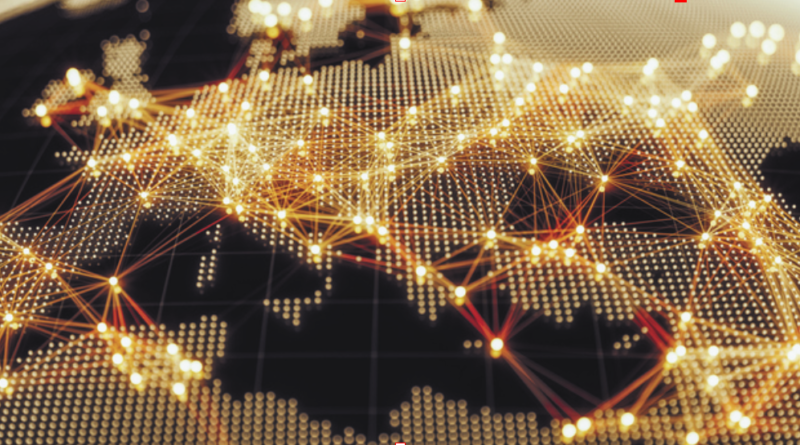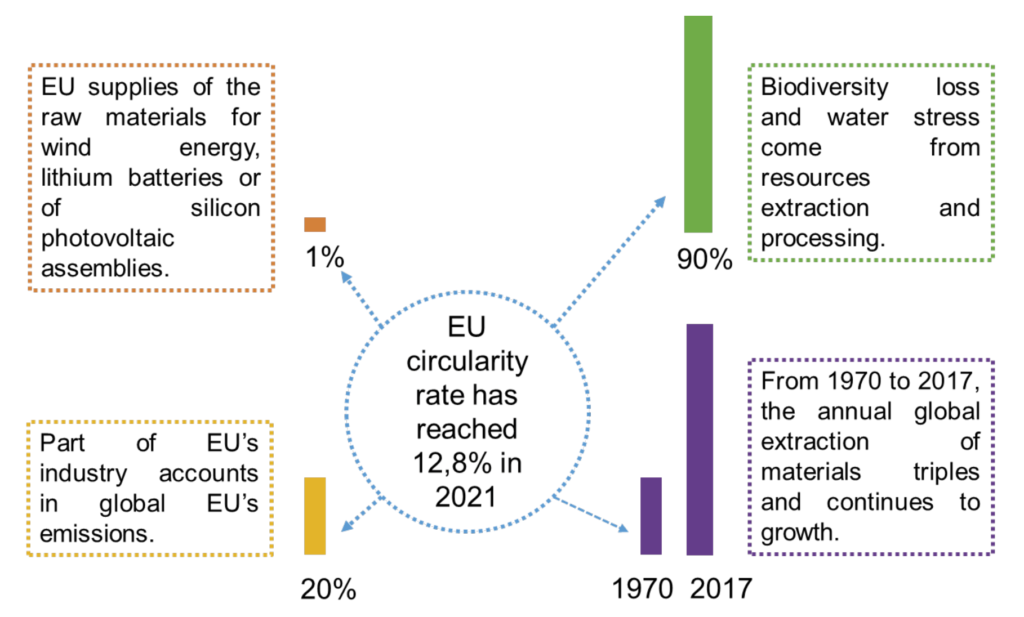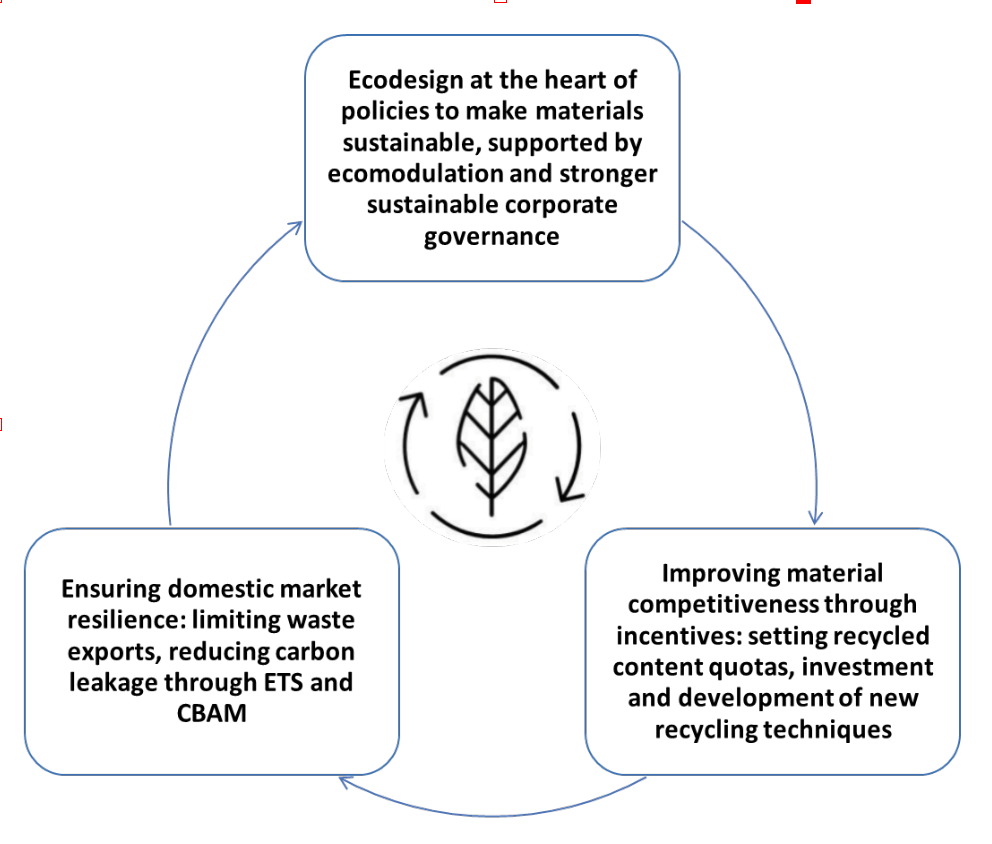
The circular economy as a tool for European strategic autonomy
In its new report, Circle Economy finds that the circular economy is only 8.6% for all products in 2021. By linking the circular economy to climate change, the report demonstrates that the rate of circularity needs to be doubled if we wish to meet our climate objectives. While the rate is slightly higher in Europe, 12.8% according to Eurostat, the lack of circularity inevitably leads to a dependence on raw materials, especially for 137 products used in 14 industrial sectors (e.g., electronics, aerospace, energy-intensive industries or automotive). Their extraction and use in order to meet increasing global needs results in environmental destruction and global warming.
If the European Union is to deepen its internal market, which is the backbone of its economy, and achieve its climate goals, it must develop a more dynamic and resilient supply of raw materials.
The pandemic and geopolitical instabilities have intensified the debate on strengthening the Union’s strategic autonomy, which has been widely supported by Thierry Breton and the European Parliament. They must now also build on the benefits of the circular economy.

For Citeo, the French company in charge of the Extended Producer Responsibility for household packaging and graphic papers, European strategic autonomy must reconcile economic issues with ecological benefits by relying on a circular economy that reduces our dependence on countries outside the European Union and by strengthening our resilience. To achieve this, Citeo believes that European efforts should be accelerated by:
Integrating eco-design issues at the core of company strategies, promoting innovation and investment to develop new recycling channels.
Developing economic tools to accelerate material competitiveness and sustainability.
Establishing complementary measures to ensure the resilience of the European market and for the benefit of countries outside the European Union, in particular about the Global Alliance on the Circular Economy and Resource Efficiency (GACERE).
Ecodesign for the sustainability of materials
Market resilience is based on systematically integrating environmental issues into the design and development of products and reducing negative environmental impacts throughout their life cycle.
With this in mind, Citeo supports the European Commission’s forthcoming Sustainable Products Initiative to ensure that eco-design is at the heart of companies’ ambitions when marketing fully reusable, repairable and recyclable products and packaging in the internal market.
Eco-design, a factor in the sustainability of materials, will be promoted thanks to eco-modulation, a system implemented by Citeo since 2011. For example, the 8% bonus associated with reducing both the weight of materials and the amount of packaging.
The other Extended Producer Responsibility channels are taking advantage of it in order to encourage marketers to improve the design of the packaging. In order to serve European strategic autonomy, this incentive must therefore be based on common principles designed to meet the challenges of reduction, reuse and recycling.
Businesses should take into account their environmental impacts and help build more resilient and sustainable supply chains within the internal market. This environmental responsibility must be, through eco-design, at the core of the business strategy to ensure sustainable production and strengthen the strategic autonomy of the Union.
The development of economic tools to accelerate material competitiveness
About 60 billion tonnes of renewable and non-renewable resources are extracted worldwide every year, an increase of almost 100% since 1980 (to meet energy supply, consumption, agriculture, etc.). Since the 1950s, the global plastics production has tremendously increased, leading to the development of a highly competitive raw materials market. However, the European Commission, with the Single-Use Plastics Directive and the forthcoming revision of the Packaging and Packaging Waste Directive; and many Member States are considering setting targets for recycled plastics in their products, thus creating an urgent need for a more competitive secondary raw material market. This market needs to be supported alongside the implementation of the European Multiannual Financial Framework’s contribution for non-recycled plastic packaging waste to encourage the Member States to make the transition to a circular economy.
It must also be possible to boost material competitiveness through investment. This is the objective of the forthcoming taxonomy regulation, which, by classifying economies as “green”, will de facto direct investments towards activities needed for the transition from a linear to a circular economy.
For this reason, Citeo welcomed this European initiative and hopes that activities related to eco-design, the development of re-use and molecular recycling, and the fight against litter can be recognised as “green.” This taxonomy must favour the “recyclable”, which will make it possible to encourage the emergence of European industrial sectors and provide a clear response to citizens’ sorting habits.
In fact, the growing demand for recycled plastic depends on the development of new recycling channels. Therefore, molecular recycling seems to be a solution to overcome the limitations of mechanical recycling. Companies have already seized the opportunity thanks to several promising projects that have been launched in Europe, particularly in the Netherlands but also and above all in France, with several projects, including two highlighted by the “Choose France” programme.

The European Union must be at the forefront of these issues by supporting the development of new recycling solutions while balancing the environmental and industrial challenges.
The need for additional measures to ensure the resilience of the internal market
Building a resilient internal market also requires limiting negative environmental externalities such as exports of waste to countries that do not have recycling technologies similar to those in the EU.
In this sense, the review of the Waste Shipment Regulation would give concrete expression to the objectives of restricting exports and boosting the European market.
This also helps to combat carbon leakage and to contribute to achieving the European Union’s 2050 carbon neutrality objectives. Thus, as early as 2005, the European Union adopted an emissions trading scheme (ETS) which allows companies to buy or sell “rights to emit”. So as to fully respect the waste hierarchy, while taking into account local specificities (e.g. overseas territories), waste incineration should be included in the ETS review.
Lastly, the carbon adjustment mechanism at the borders (CBAM) project, which defines an acceptable GHG emission threshold on all goods imported into the EU (currently the iron and steel, cement, fertiliser, aluminium and power generation sectors are concerned), will promote competitiveness by limiting relocation to countries with lower environmental standards and mitigating the competitive imbalance to which companies are subject. Citeo supports the integration of polymers, glass and paper into this mechanism. This will strengthen the European recycling market and will support a similar level of price competitiveness between products whose source is recycled and products from virgin raw materials.




